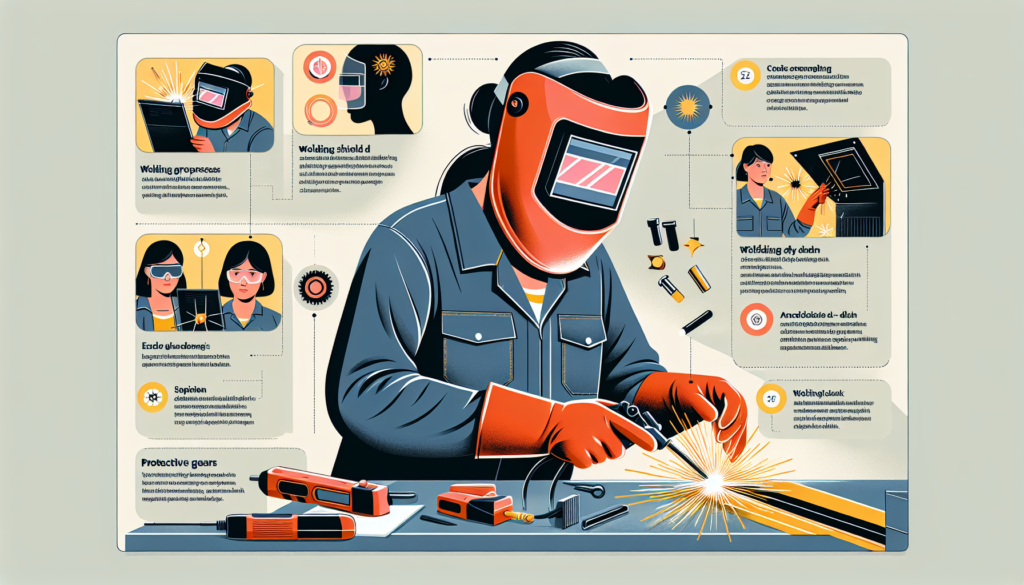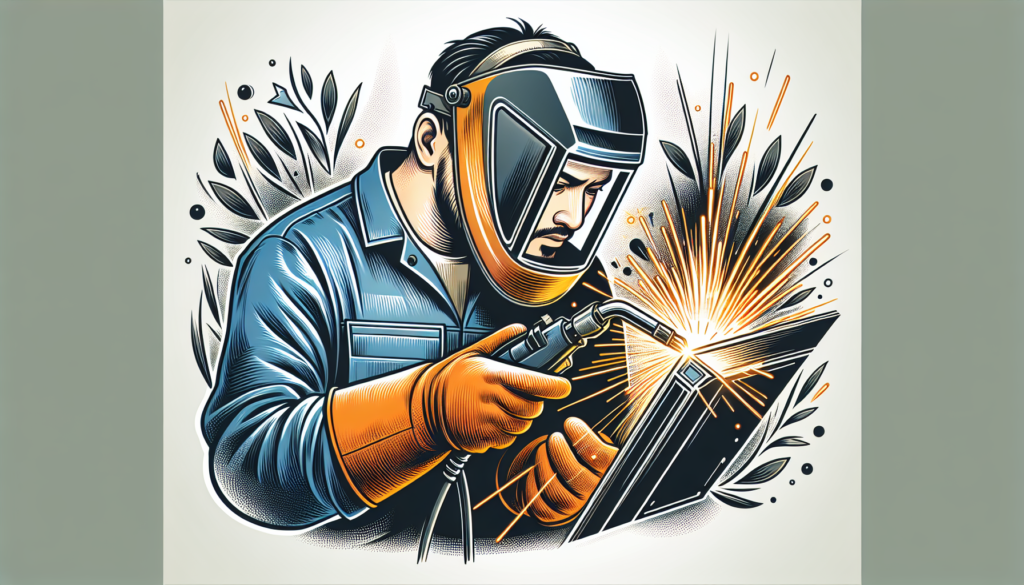Imagine being able to weld with complete ease and protection. Introducing the welding shield with a built-in helmet – a game-changer for welding professionals! This innovative piece of equipment combines the functionalities of a protective shield and a helmet, ensuring maximum safety and convenience. Gone are the days of constantly switching between a shield and a helmet; now you can focus on your work without any distractions. This welding shield with a helmet is designed to provide you with the highest level of protection and comfort, allowing you to weld with confidence and peace of mind. Say goodbye to cumbersome gear and hello to a seamless welding experience!
Overview of Welding Shield with Helmet
A welding shield with helmet is a crucial piece of equipment used in welding operations. It combines a protective shield for the face and eyes with a sturdy helmet to ensure maximum safety and visibility during the welding process. Whether you are a professional welder or an enthusiast, using a welding shield with helmet is essential to protect yourself from potential hazards.
What is a welding shield with helmet?
A welding shield with helmet is a specialized piece of safety equipment that consists of a shield or visor to protect the face and eyes from welding sparks, heat, and harmful ultraviolet/infrared (UV/IR) radiation. The helmet component of the device provides head protection and allows for the attachment of the shield.

Why is it important for welding?
Welding involves the use of intense heat, sparks, and harmful radiation, making it necessary to have proper protective equipment. A welding shield with helmet acts as a barrier between your face, eyes, and potentially dangerous elements, such as flying sparks, intense heat, and UV/IR radiation. It keeps you safe from burns, eye injuries, and long-term damage caused by exposure to harmful light.
How does it work?
A welding shield with helmet works by incorporating an auto-darkening lens that filters out the harsh light emitted during the welding process. When not in use, the lens remains transparent, allowing for clear visibility. As soon as the welding arc starts, the lens darkens automatically to protect your eyes from the bright light. This auto-darkening feature ensures that your eyes are shielded from harmful rays without the need for manually changing the lens.

Types of welding shield with helmet
There are several types of welding shields with helmets available on the market, each designed for specific welding applications and environments. Some of the common types include:
-
Standard welding shield with helmet: This type is suitable for general welding tasks and features a fixed shade lens that provides adequate protection for most welding operations.
-
Variable shade welding shield with helmet: This type allows you to adjust the darkness level of the lens according to the specific welding process or environment. It offers more versatility and flexibility.
-
Powered air welding shield with helmet: These shields are equipped with a built-in air filtration and ventilation system to protect against fumes, gases, and particulate matter. They are ideal for welding in enclosed spaces or hazardous environments.
-
Grinding shield with helmet: Specifically designed for grinding and cutting operations, this type of shield features a clear lens that is impact-resistant and protects against debris and sparks generated during these tasks.
Key Features of a Welding Shield with Helmet
A welding shield with helmet comes with various features that enhance comfort, safety, and overall efficiency. Some of the key features to look for include:
Auto-darkening lens
The auto-darkening lens automatically adjusts to varying light conditions, ensuring that your eyes are protected from harmful radiation at all times. With this feature, you no longer need to manually lift or lower the shield during welding, allowing for uninterrupted work and better precision.
UV/IR protection
The welding shield with helmet should provide reliable protection against ultraviolet and infrared radiation, which are produced during the welding process. Both types of radiation can cause serious damage to the eyes and skin, so it is crucial to choose a shield that offers effective UV/IR protection.
Adjustable sensitivity and delay settings
Having adjustable sensitivity and delay settings allows you to customize the performance of the auto-darkening lens. You can fine-tune the responsiveness of the lens to match the intensity of the welding arc, resulting in optimal protection and comfort.
Comfort and ergonomics
Welding is often a time-consuming process, so it is important to choose a welding shield with helmet that prioritizes comfort and ergonomics. Look for features such as adjustable headgear, padded interiors, and lightweight design to minimize strain and fatigue during long welding sessions.
Benefits of Using a Welding Shield with Helmet
Using a welding shield with helmet offers numerous benefits that contribute to a safer and more efficient welding experience. Here are some of the key advantages:
Enhanced safety and protection
The primary benefit of using a welding shield with helmet is the enhanced safety and protection it provides. By shielding your face and eyes from sparks, heat, and harmful radiation, it significantly reduces the risk of burns, eye injuries, and long-term damage caused by UV/IR radiation exposure.
Improved visibility and accuracy
A high-quality welding shield with helmet improves visibility by reducing glare and providing a clear line of sight to the welding area. This enhanced visibility allows for better accuracy, leading to precise welds and reduced chances of errors or rework.
Reduced eye strain and fatigue
The auto-darkening lens in a welding shield with helmet eliminates the need for constant manual adjustment, reducing eye strain and fatigue. Additionally, the comfortable fit and ergonomic design of the helmet ensure that you can work for extended periods without discomfort.
Efficient and productive work environment
By providing a safe and comfortable work environment, a welding shield with helmet promotes productivity. With reduced downtime for adjustments and increased focus on the task at hand, you can complete welding projects efficiently and effectively.
Choosing the Right Welding Shield with Helmet
When selecting a welding shield with helmet, it is important to consider various factors to ensure that you choose the right one for your specific needs. Here are some key factors to keep in mind:
Consider the type of welding
Different welding processes require different levels of protection. Determine the type of welding you will be performing most frequently and choose a shield with an appropriate shade level suitable for that particular process.
Evaluate lens shade options
Different welding shield lenses come with varying shades that determine how much light is filtered out. Evaluate the lens shade options available and select the one that matches the intensity of the welding process you will be working with.
Look for ANSI and CE certifications
To ensure the welding shield with helmet meets the necessary safety standards, look for certifications such as ANSI (American National Standards Institute) and CE (Conformité Européene). These certifications guarantee that the product has undergone rigorous testing and meets industry regulations.
Comfort and fit
Try on different helmets to find one that fits comfortably on your head. Look for adjustable headgear, cushioned interiors, and a secure strap system to ensure a snug and comfortable fit. Remember, a well-fitting helmet will be more comfortable to wear for extended periods.
Quality and durability
Invest in a welding shield with helmet that is made from high-quality materials and built to withstand tough working conditions. Check customer reviews and ratings to gauge the durability and reliability of the helmet, as you want a product that will last long and provide consistent protection.
Maintenance and Care of Welding Shield with Helmet
Proper maintenance and care of your welding shield with helmet are crucial to ensure its longevity and effectiveness. Follow these guidelines to keep your equipment in optimal condition:
Regular inspection and cleaning
Inspect your welding shield with helmet regularly for any signs of damage or wear. Pay special attention to the lens, headgear, and straps. Clean the helmet and shield using a mild soap or cleaning solution, and wipe them dry with a soft cloth to remove any dust, debris, or residue.
Replacing worn-out parts
If any parts of your welding shield with helmet become worn out or damaged, such as the headgear or lens, it is important to replace them promptly. Using worn-out equipment compromises your safety and reduces the effectiveness of the shield.
Protective storage
When not in use, store your welding shield with helmet in a clean and dry area, away from direct sunlight and humidity. Consider using a protective case or bag to prevent accidental damage and keep the equipment in good condition.
Proper maintenance of the lens
The lens of your welding shield with helmet is one of its most critical components. Follow the manufacturer’s instructions for cleaning and maintaining the lens, as well as any recommended replacement intervals. Regularly check the lens for scratches or damage, as a compromised lens may not provide adequate protection.
Common Concerns and FAQs about Welding Shield with Helmet
As a welder, you may have some concerns or questions regarding the use of a welding shield with helmet. Here are answers to some common FAQs:
Can a welding shield with helmet protect against sparks and splatter?
Yes, a welding shield with helmet is designed to protect your face and eyes from sparks, splatter, and flying debris. It forms a barrier between you and the welding process, preventing any hot particles from reaching your skin or eyes.
How long does the lens of a welding shield last?
The lifespan of a welding shield lens depends on various factors, including the quality of the lens, frequency of use, and the intensity of the welding process. On average, a lens can last anywhere from six months to several years. However, it is essential to regularly inspect the lens for any signs of damage and replace it when necessary.
Are there any safety precautions while using a welding shield with helmet?
Yes, it is important to take certain safety precautions while using a welding shield with helmet. Always ensure that the shield is in good condition before use and that it fits properly on your head. Additionally, wear appropriate protective clothing, such as flame-resistant clothing, gloves, and boots, to minimize the risk of burns or injuries.
Can a welding shield with helmet be used for other applications?
While a welding shield with helmet is primarily designed for welding operations, it can also be used for other applications that involve similar hazards, such as cutting, grinding, or brazing. However, it is essential to ensure that the shield provides adequate protection for the specific task at hand.
Are there any specific guidelines for storing a welding shield with helmet?
When storing your welding shield with helmet, keep it in a cool, dry, and clean area. Avoid exposing it to direct sunlight, extreme temperatures, or high humidity, as these conditions can damage the helmet and reduce its effectiveness. Consider using a storage case or bag to protect the shield from accidental damage. Additionally, follow any specific storage instructions provided by the manufacturer.
Tips for Using a Welding Shield with Helmet
To maximize the benefits and effectiveness of your welding shield with helmet, consider the following tips:
Proper positioning of the helmet
Ensure that the helmet is positioned securely and comfortably on your head before starting any welding operations. A well-fitted helmet will provide better protection and minimize the risk of discomfort or distractions during work.
Adjusting the lens settings
Take the time to adjust the lens settings of your welding shield according to the specific welding process, ambient light conditions, and your personal comfort. Use the sensitivity and delay settings to fine-tune the responsiveness of the auto-darkening lens for optimal protection and visibility.
Checking the integrity of the shield
Before using the welding shield with helmet, inspect it for any signs of damage, worn-out parts, or loose fittings. Tighten any loose screws or straps, and replace any damaged components before starting work. This will ensure that the shield functions as intended and keeps you safe.
Regular breaks to avoid fogging
During long welding sessions, take regular breaks to allow your welding shield with helmet to cool down and prevent fogging of the lens. Wearing a highly ventilated helmet or using an anti-fogging solution can also help reduce fogging issues.
Utilizing additional safety gear
While a welding shield with helmet provides essential protection, it is advisable to use additional safety gear, such as gloves, flame-resistant clothing, and ear protection, depending on the specific welding process and environment. This will further enhance your safety and minimize the risk of injuries.
Conclusion
A welding shield with helmet is a crucial component of a welder’s safety gear. It provides protection against sparks, heat, and harmful UV/IR radiation, ensuring a safe and efficient welding experience. By choosing the right welding shield with helmet, maintaining it properly, and following safety guidelines, you can enjoy improved safety, enhanced visibility, and increased productivity during welding operations. Invest in a high-quality welding shield with helmet today and prioritize your safety in every welding project you undertake.
